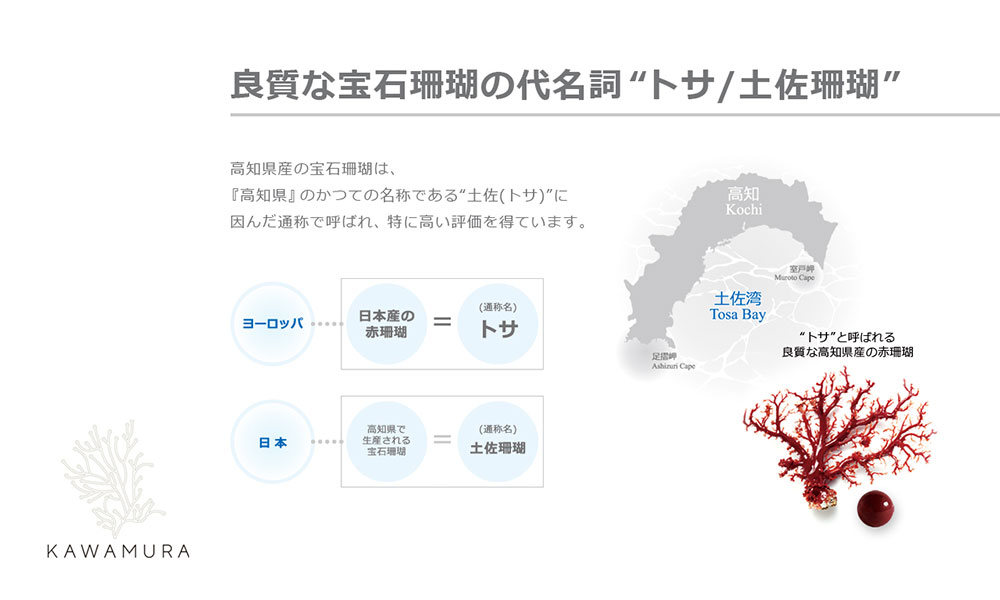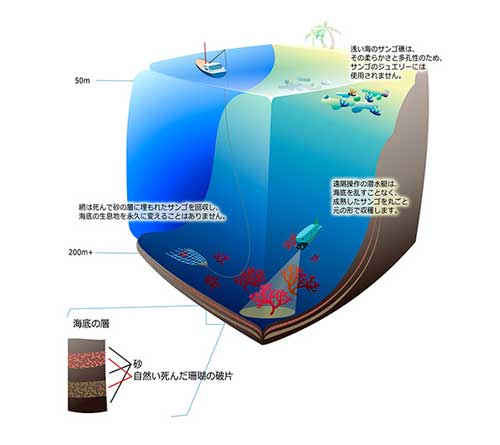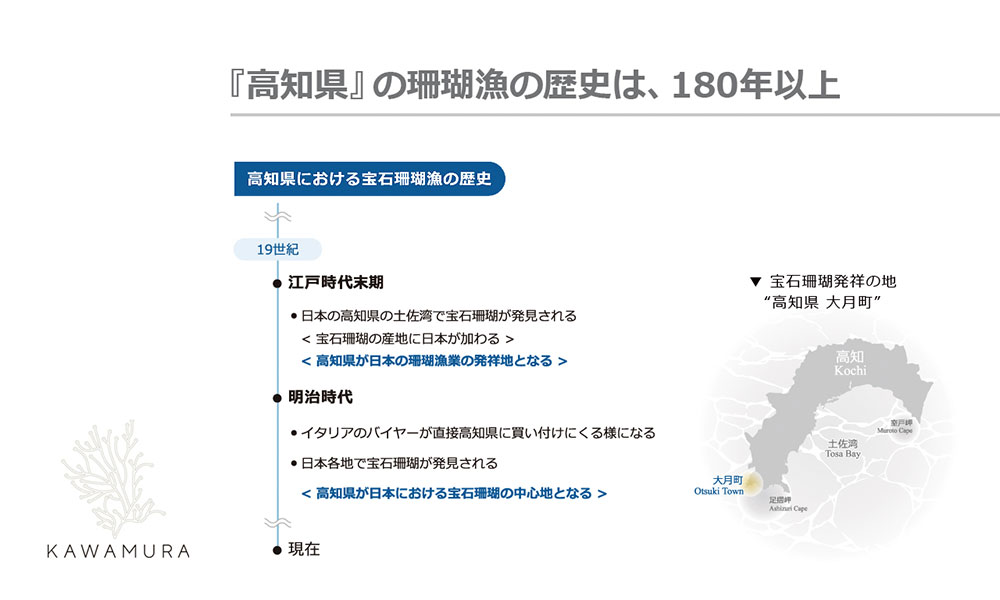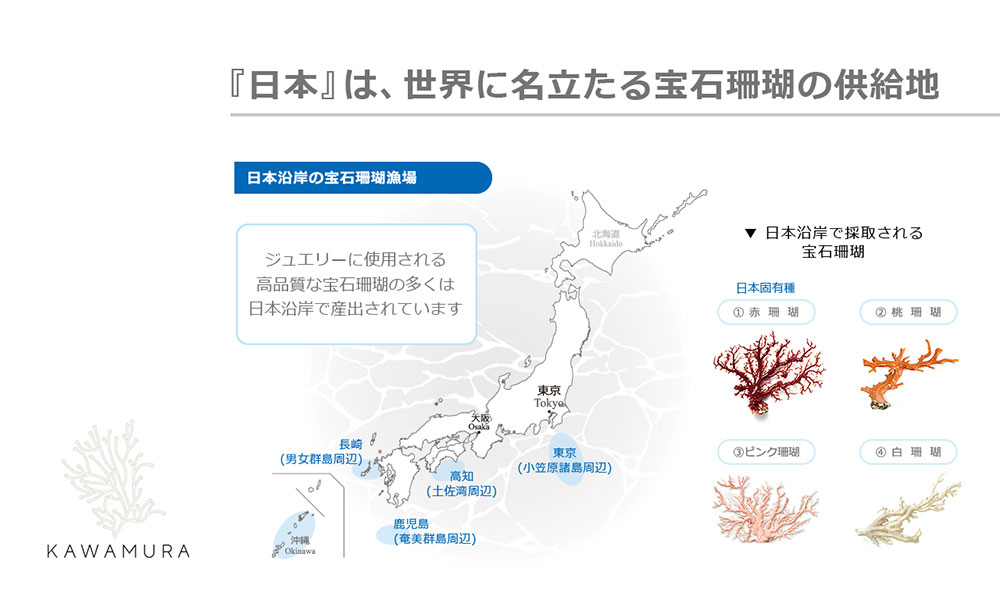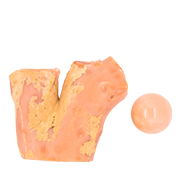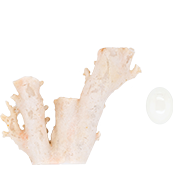Precious Coral
Currently, Japan produces almost no jewelry, with the exception of coral and pearls, which are globally recognized as their main source.
In particular, the red coral collected in Kochi Prefecture has the highest reputation in the world, and is called "TOSA" by European buyers, and is synonymous with beautiful red coral.
Precious Coral
Coral, along with pearls and amber, is a gem of organic origin that is not a mineral.
While most gems are minerals, coral is a special gem made by the animal "coral".
Precious coral is different from the commonly known reef-building coral. It takes hundreds of years to grow in the deep sea over 100 meters and be ready for jewelry.
Reef-building coral
It is generally called reef-building coral (so-called coral reef, table coral, mortar coral, stone coral, etc.), and it is used for sunlight with a seawater temperature of 20 ° C or higher up to a depth of 50 m in shallow water such as Okinawa in the tropical and subtropical regions and the sea near Hawaii. It grows on a shallow coastline that can be reached.
Hexacorallia grows 7 to 8 cm a year at the earliest, has small holes and is very soft, so it is not processed as jewelry.
Precious coral and its origins around the world
Mediterranean coral that was introduced to Japan through the Silk Road. In addition, Japanese coral is collected off the coast of Tosa.
In England and France, coral is said to be a talisman for safe delivery and healthy growth of children, as well as a talisman for evil spirits.
In Italy, it is said that if you wear red things during the year-end and New Year holidays, you will be able to stay healthy for a year without any illness, and it seems that you are wearing Mediterranean coral and red coral.
It is also said that in ancient Rome, soldiers went to the battlefield with coral as a talisman for the good luck and healthy growth of children, as well as a talisman to protect against evil and injuries.
The famous story is that Crusader soldiers wore coral along with the cross.
In addition, there is a custom to use it as a talisman, health, and evil eye protection in India, and as one of the Buddhist cloisonne in China.
History of jewel coral
The history of precious coral dates back more than 20,000 years.
Coral beads have been excavated from Paleolithic ruins (about 25,000 years ago) in Wurttemburg, Germany. Originating on the Mediterranean coast, it has been used as a talisman of good luck and happiness in ancient Greece and Rome.
At first, it became prized in the surrounding Christian countries. Eventually, coral jewelry in the form of rosaries and necklaces spread worldwide. It went east on the Silk Road, was accepted in each region, and was useful as a talisman in the world's three major religions (Christianity, Islam, and Buddhism). It came as a treasure of the royal aristocrats in the 7th and 8th centuries when the traffic of envoys to Tang and others became popular. The oldest surviving coral in Japan is the coral ball used for the crown used by Emperor Shomu (Reign period 724-749) in the Imperial Treasure of Shosoin in Nara Prefecture. The discovery of Japanese products began in 1812 at the end of the Tokugawa period, when it was discovered at Cape Muroto in the Tosa domain (Kochi prefecture).
Precious coral and royal family
Coral has been loved and transmitted all over the world as a jewel or amulet since ancient times.
Coral, which can be said to be a symbol of the sea that gives various blessings, has a long history of being used by the royal families of many countries because of its preciousness, beauty, and role as an amulet.
British royal family
Coral is loved as a jewel that brings "prosperity" and "beauty" to women, and at the time of her birth, Queen Elizabeth II was presented with a pink coral necklace as her first necklace. Her daughter, the first princess, Anne Elizabeth I, is said to have worn her coral necklace as a talisman for her childbirth when she gave birth. Also, as a custom, it seems that a coral necklace is hung on the bed for one year from the birth of the princess.
Qing dynasty, China
Not only as a jewel in China, but it has been regarded as one of the Buddhist cloisonne since ancient times. Therefore, it was also used as a formal dress used by the imperial family during ceremonies.
In Qing Dynasty China, coral is used as jewelry worn by the royal family during large ceremonies, and when the emperor performs a sun ritual (holiday), he wears red clothes and a red coral necklace. It is said that of the three necklaces worn by the empresses and empresses, two were coral necklaces.
Monaco royal family
Monaco Totsugi to the royal family, former actress became the Princess of time, also Grace Kelly has been handed down that he had and love the coral. In particular, the figure had been favorite earrings peach coral in the public service has been seen often.
Precious Coral Variety
Japanese Red Coral (Oxblood‘AKA’Coral)
There are two types of red coral, the sea near Japan (mainly off the coast of Tosa) and the salji that can be found mainly in the Mediterranean Sea.
Among them, the highest quality one is collected off the coast of Kochi prefecture and is called blood red coral. As the name suggests, blood red coral is a deep-colored coral with a very high rarity value. The feature is that there is a white part called "fu" in the center of the branch. It inhabits water depths of 100 to 300 m. Characterized by a deep deep red color, it is highly regarded worldwide for high jewelry.
Meaning as a gemstone (red coral): Keeps the body strong and enhances imagination and execution.
Mediterranean Coral
Mediterranean coral is a species that inhabits a lot in the shallow water (50m ~) near the island of Sardinia in Italy.
Because the water depth is shallow, it grows quickly and does not grow very large. (Even large ones are about 30 cm in height) Therefore, it is suitable for small parts such as beads. There is no red coral or peach coral in the log of Mediterranean coral, and there is little color unevenness because it has a single color tone.
Meaning as a gemstone (red coral): Keeps the body strong and enhances imagination and execution.
Momo Coral
As the name suggests, there are a wide range of shades, from pink to colors close to red and white. The feature is that there is a white part called "fu". Those that do not have this fluff, have a light color tone and almost no color unevenness are called bokeh and angel skin, and have a high rarity value.
It is a coral that is widely distributed from the waters near Japan to the waters near Taiwan, and is the largest of the jewel corals.
Often used for sculpture, it is also used as a part of Asian folk costumes.
Meaning as a gemstone: Symbolizes pure love, loyalty, and kindness. It works on the mind and soul, and the subconscious mind blooms.
Angelskin‘Bokeh’Coral
It is said to be a phantom coral and is rarely collected.
It has a beautiful pink color and is prized as an angel skin in Europe.
Above all, the finest coral collected from peach coral, which is said to be honboke, is extremely valuable whether or not it can be collected once every 10 years.
Pink coral
There is a wide range of sampling areas, from the waters near Japan to off Hawaii, the South China Sea, and the Battle of Midway. Therefore, there are various types, such as garnet, miss (hime), mid, and deep sea.
Unlike peach coral, there is no fu. The color tone ranges from light pink to dark pink, which is a mixture of pink and white.
Meaning as a gemstone: Symbolizes pure love, loyalty, and kindness. It works on the mind and soul, and the subconscious mind blooms.
White Coral
It is based on white, but there are also pale pink and ivory colors. It mainly inhabits the waters near Japan, but it also grows off the coast of Hawaii. Among them, there are very few unmixed whites called pure whites.
Meaning as a gemstone: A symbol of service and sacrificial tenderness. It means purity and is said to bring happiness.
The main coral used in jewelry
Precious coral
Precious corals live in the deep sea and require decades to grow 1 cm. Since it lives in a place with extremely high water pressure, it has a Mohs hardness of about 3.5 degrees and is as hard as human teeth, making it suitable for jewelry.
Bamboo coral
A type of hexacoral that lives in relatively shallow water, and is often used as a material for dyed coral. The original color is white and the characteristic is that you can see the streaks that are aligned with the generation.
Although it is a natural coral, it is not a natural jewel coral (real coral).
It is often used in beads.
Maintaining Precious Coral Jewelry
KAWAMURA offers complimentary standard maintenance service for its high-end coral jewelry brand products.
The main component of gem coral is calcium carbonate, and acidic substances such as sweat and cosmetics may dull the shine and discolor the stone. After wearing your jewelry, please wipe it with a clean, soft cloth. Hot springs, soaps, and shampoos can contain corrosive components such as sulfur and others acids, so please remove your jewelry before when bathing.
Precious coral precautions
- Natural coral is a very delicate gem. In addition, the main component of coral is calcium carbonate, which tends to be particularly vulnerable to acids such as sweat and fruit juice, and may become dull when exposed to acids.
- Coral may crack due to pressure difference when it is pulled out from the deep sea, but please be assured that it will not damage or crack the product.
- Also, because it is a natural material, there may be "scratches" and "scratches" that are created because it was a habitat for marine life when it lived in the deep sea. (It is not an artificial wound)
- Even if they have the same design and color, the colors may be different one by one. Since it is a color unevenness peculiar to natural coral grown naturally, please enjoy the unique color in the world as the individuality of jewel coral.

